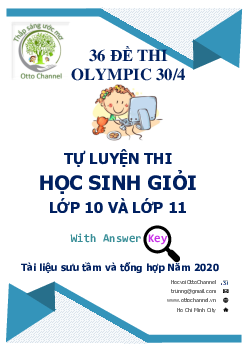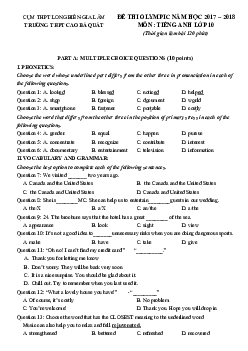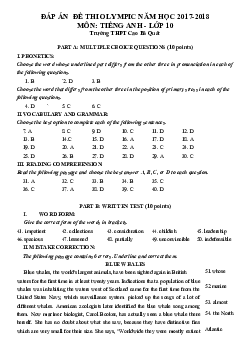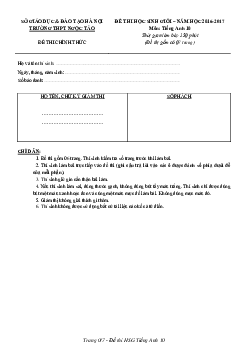









Preview text:
SỞ GIÁO DỤC VÀ ĐÀO TẠO HÀ NỘI
ĐỀ THI CHỌN HỌC SINH GIỎI KHỐI 10
TRƯỜNG THPT NGÔ QUYỀN-BA VÌ NĂM HỌC 2012-2013 Môn: TIẾNG ANH
Thời gian làm bài: 180 phút
(Không kể thời gian giao đề) Giám thị 1 Giám thị 2 Mã phách
Họ và tên: ................................................
Số báo danh: ...........................................
Phòng thi: ............................................... ĐIỂM BÀI THI Bằng Giám khảo 1 Giám khảo 2 Mã phách Bằng chữ số Your answers 1 2 3 4 5 6 7 8 9 10 11 12 13 14 15 16 17 18 19 20 21 22 23 24 25 26 27 28 29 30 31 32 33 34 35 36 37 38 39 40 41 42 43 44 45 46 47 48 49 50 51 52 53 54 55 I. PHONETICS
A. Mark the letter A,B,C,or D to indicate the word whose underlined
part is pronounced differently from that of the others. 1. A conserve b. reside C. resume D. preserve 2. A. ploughs B. photographs C. gas D. laughs 3. A. exhibit B. exhibition C. example D. exsistence 4. A. sentenced B. proved C. rushed D. laughed 5. A. provision B. inversion C. explosion D.occasion
B. Choose one option A, B, C or D corresponding to the word whose
main stress is on the syllable in the position which is different from that of the others. 6. A. establish
B. development C. specializing D. foundation 7. A. eternal B. calendar C. dinosaur D. history 8. A. document B. develop C. opponent D. astonish 9. A. impossibly B. surprisingly C. unfortunately D. mentally 10. A. definition B. humidity C. necessity D. incredible
II. VOCABULARY AND GRAMMAR:
Circle the letter next to the word or phrase which best completes each sentence:
11."Can I help you? " "-------------------"
A. No, thanks. I'm just looking B. Yes, I'm watching C. No, I'm seeing D. Yes, I'm thinking 1
When our friends have bad fortune, we try to show___________. 2. A. love B. sympathy C. affection D. pity 1
She should have been here but she’s _____________ flu. 3. A. come in for B.gone through C.gone down D. come up with with against
14. You have to study harder to ____________ your classmates.
A. keep in B. keep pace C. keep out D. keep up touch with of
15. It is imperative that this letter __________ immediately. A. were sent B. sent C. be sent D. send
16. Two of the boys in the art class were doing self-portraits by
looking at ________ in the mirror. A. B. oneself C. each other D. one another themselves
17. They named their daughter .................... their favourite movie star. A. of B. for C. after D. on
'18. Your fur coat looks very expensive."
"-------------------. It was secondhand." A. Yes, it does B. I'm sorry. C. Really? It wasn't expensive D. No, it isn't
19. Your progress will be----------------- in six months' time. A.counted B. valued C. evaluated D. enumerated
20. My mother used to ........................ research in this library when she was a student. A. make B. do C. doing D. making
21. Let’ s go to the beach this weekend, ...........................................? A. shall we B. do we C. don’ t we D. let we
22. I can ' t find the tickets. I seem ................ them. A. to have lost B. to lose C. losing D. to lost
23. Take your coat with you .................. it gets cold later. A. if B. as long as C. when D. in case
24. John wasn ' t at work yesterday. He ........................ A. must have been ill. B. must be ill. C. must have ill . D. must to be ill.
25. My father has gone away. He' ll be back .......... a week. A. for B. at C. until D. in
26. ....................... didn't visit this part of the town.
A. Almost tourists B. Most of the tourists C. The most tourists D. Many tourist
27. What she said............... me................... unhappy. A. made / to feel
B. made / feel C. made / felt D. to make / feel
28. I haven ' t seen her for .................... that I have forgotten what she looks like. A. so long time B. a so long time C. a such long time D. such a long time
29. Do you know all the guests ........................ to the party ? A. inviting B. invited C. who invited D. were invited
30. How beautiful she is ! She is wearing a ........................................... . A. silk pretty purple dress. B. dress silk pretty purple. C. purple pretty silk dress. D. pretty purple silk dress.
III. Choose the word or phrase which must be changed in order
for the sentence to be correct.
31. Dr. Marti Luther King, clergyman and civil rights leader, won the 1964 Nobel Peace Prize A B
for his work toward racially equality in the United States. C D
32. Douglas was driving along the dirt road when his car broke down in the middle of the road. A B C D
33. A lot of information on the Internet are not reliable. A B C D
34. The midnight sun is a phenomenon in which the Sun visible remains in the sky for twenty- A B C four hours or longer. D
35. Lawrence Robert Klein received the 1980 Nobel Prize in economics for pioneering the A B
useful of computers to forecast economic activities. C D IV. READING
A - Read the following reading passage and choose the correct answers
Fog is a cloud in contact with or just above the surface of land or sea. It
can he a major environmental hazard. Fog on highways can cause chain-
reaction accidents involving dozens of cars. Delays and shutdowns at
airports can cause economic losses to airlines and inconveniences to
thousands of travelers carrying vast quantities of oil, increases the possibility of catastrophic oil spills.
The most common type of fog, radiation fog, forms at night, when moist
air near the ground loses warmth through radiation on a clear night. This
type of fog often occurs in valleys, such as California's San Joaquin Valley.
Another common type, advection fog, results from the movement of warm,
wet air over cold ground. The air loses temperature to the ground and
condensation sets in. This type of fog often occurs along the California coast
and the shores of the Great Lake. Advection fog also forms when air
associated with a warm ocean current blows across the surface of a cold
current. The thick fogs of the Grand Banks of Newfoundland, Canada, are
largely of this origin, because here the Labrador Current comes in contact with the warm Gulf Stream.
Two other types of fog are somewhat more unusual. Frontal fog occurs
when two fronts of different temperatures meet, and rain from the warm
front falls into the colder one, saturating the air. Steam fog appears when
cold air picks up moisture by moving other warmer water.
36. The first paragraph focuses on which aspect of fog? A. Its dangers.
B. Its composition. C. Its beauty. D. Its causes.
37. The word catastrophic is closest in meaning to …… A. accidental
B. inevitable C. unexpected D. disastrous
38. According to the article, fog that occurs along the California coast is generally …… A. radiation fog B. advection fog C. frontal fog D. steam fog
39. It can be inferred from the passage that the Labrador Current is …… A. cold B. weak C. polluted D. warm
40. The author organizes the discussion of the different types of fog according to …… A. their geographic locations B. their relative density
C. the types of problems they cause D. their relative frequency
41. The author of the passage is probably an expert in the field of …… A. physics
B. economics C. transportation D. meteorology
42. According to the article, fog that forms through radiation process of moist air is generally …… A. radiation fog B. advection fog C. frontal fog D. steam fog
43. Which is not true of the frontal fog? A. It is quite common.
B. It forms when two fronts of different temperatures meet. C. The air is soaked.
D. The warm front has rain falling into the colder front.
44. Which of the following is not caused by fog? A. Tankers' crash. B. Pile-up accidents
C. Shutdowns at airports. D. Temperature losses.
45 . Grand Banks of Newfoundland, Canada, is mainly affected by …… A. radiation fog B. advection fog C. frontal fog D. steam fog
B. Choose the word that best fits each of the blanks in the following passage.
Set in the red desert of central Australia is the mining town of Coober Pedy. At first sight, the
town looks similar to many other such communities, but Coober Pedy is different. Sixty per cent
of its population of some 4,000 people live underground. There are today about 800 underground
houses as well as shops, hotels and even churches in the town and the (46) ___ hills. Once a site
has been chosen, special tunneling machines are (47) ___ in to create passages and rooms in the
sandstone. Rock pillars are left to (48) ___ the roof, and doors and windows are cut into the
front. Houses are of all shapes and (49) ___, the largest having twenty rooms, and some even have their own swimming pool.
Living underground may sound strange but in fact it has a number of advantages. In swimmer,
the temperature outside can reach an astonishing 47°C, and in winter the nights can be (50) ___
cold. However, inside the houses it remains a steady 25°C all year (51) ___. Many people say
that living underground makes them feel very secure. There is no problem with noise from the
neighbors and the houses are not (52) ___ by the fierce dust storms that regularly (53) ___
through the area. And of course, if your family (54) ___ or lots of friends come to stay, you can (55) ___ dig another room. 46. A. near B. enclosing C. close D. surrounding 47. A. placed B. entered C. brought D. worked 48. A. rise B. lift C. support D. push 49. A. areas B. sizes C. numbers D. volumes 50. A. heavily B. extremely C. sharply D. strongly 51. A. across B. round C. along D. wide 52. A. influenced B. affected C. spoiled D. disturbed 53. A. pour B. flood C. hurry D. sweep 54. A. grows B. explodes C. stretches D. rises 55. A. regularly B. only C. ever D. always
C . Fill in each blank with a suitable word. LOOKING FOR A JOB
I finished university six month ago, I’ve got a degree in business
administration. I enjoyed the course very much (56)…….…….I realize I
should have studied a lot harder! A few of my friends have (57)……………got
full-time jobs but most, me, are still waiting (58)………..… something suitable
to turn up. Meanwhile, I make sure that I keep myself busy. I look through the
job (59)……………in the newspapers every day and I also ask all the people I
know to tell me if they hear of any vacancies (60)……………...they work .
What I am looking for is something challenging and I would certainly be
happy to move to another city or even work abroad for a while. The (61)
………….… is not so important at this stage , provided I earn enough to live
on , because I don’t want to continue (62)………………. to depend on my
parents , although they are (63)………………..generous to me . At the
moment, I’m working in a nearby restaurant two evenings a week, washing
up and generally helping out, which brings a little money . The other people
working there are very friendly, and many of them are in the same (64)
………………as me, so we have lots of to talk (65)………………… 56. 57. 58. 59. 60. 61. 62. 63. 64. 65.
V. Complete the following sentences with the appropriate forms
of the words in parentheses. 66-67. The
............................................... you write,
the ................................... your mark will be. ( CARE / BAD )
68-69. It's ................................. to drink the water because it hasn't
been ................................ yet. ( POSSIBLE / PURE )
70-71. The trip was .................................. .......................................... ( EXTREME / ENJOY )
72-73. I believe in ..............................( PREVENT ) diseases
because ............................... is always better than cure. ( PREVENT )
74-75. The coal industry was ................................. private but
was ...................................... in the 1940s. ( ORIGIN / NATION) 66. 67. 68. 69. 70. 71. 72. 73. 74. 75.
VI. Put the verbs in brackets in the correct tense or form
76.Linda has lost her passport again. It ' s the second time
this ....................................... ( happen )
77. It was a great party last night. You ........................................................... Why didn't you ? ( come ) 78. " Ann is in hospital. " " Yes, I know.
I .......................................................... her tomorrow. " ( visit )
79. The paintings----------------------on the way they---------------------to Dr. Brown's. (disappear/ take)
80. Were you ...........................a littlte time, you'd be able to join us. ( have )
81. I don ' t feel like ................. out this evening. I .....................................in the garden all day. ( go / work)
82. Are you having your house ....................................... at the moment ? ( paint )
83. If I .............................................. the doctor ' s advice, I would be better now. (follow )
84. I-------------------- the short story just as Karen ------------------ in from work. (finish\ come)
85." I can't remember us ever--------------------," replied the stranger. (meet) 76. 77. 78. 79. 80. 81. 82. 83. 84. 85. VII. WRITING
Rewrite the sentences , using the words given:
86. The keeper had no sooner opened the cage door than the lion attacked him.
Hardly _______________________________________________________.
87. No other city in Vietnam is so large as Ho Chi Minh City.
Ho Chi Minh City is ______________________________.
88. They produce a lot of paper, so they need a lot of wood pulp.
The more _________________________________________.
89. We spent our childhood in that beautiful mountain resort, and we always remember it.
We always ____________________________________________________________.
90. She insisted that she should be called Joyce.
She insisted on ______________________.
91. It might be a good idea to use honey instead of sugar.
Why _______________________________________.
92. He never suspected that the money had been stolen.
At no _____________________________________.
93. They are going to repair my car tomorrow.
I am going to have…………………………………….
94 .They were all arrested because of his incompetence.
Had_________________________________________________________________________.
95 . The trip was so interesting that we couldn’t forget it.
It…………………………………………………….
96 .The only way to eliminate world terrorism is by untied opposition. BY
----------------------------------------------------------------------------------------------------------- ---------
97 . I don’t really like her even though I admire her achievements. AS
----------------------------------------------------------------------------------------------------------- ---------
98 . His second attempt on the world record was successful. BROKE
----------------------------------------------------------------------------------------------------------- ---------
99 . He’s the best player our team has ever had. SUCH Our
team...................................................................................................good player.
100 . Mrs Scott is proud of her cooking. TAKES Mrs
Scott.................................................................................................................. THE END




